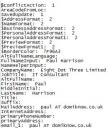I’m not sure if Lotus intended for this to be publicly available yet, but for those of you interested in the new Notes Traveler facility due to ship with N/D 8.0.1, you can find its on-line documentation here
Lotus Notes Traveler Documentation Available On-Line
January 9th, 2008SnTT: Preventing Sametime Users from Accessing Hidden Groups
November 22nd, 2007This SnTT is a Sametime related follow-up to an excellent SnTT posting a short while back, by Paul Mooney, entitled Preventing users from mailing specific groups.
It’s a great tip. However if you share your Domino Directory (and its hidden groups) with your Sametime Server, then I recently discovered a potentially nasty caveat in using this technique, which I think is important to share, particularly if the members of these groups are private and confidential, such as for example, client email addresses.
Basically, whilst these groups are effectively protected by Readers Names fields which prevents (unspecified) Notes users viewing or accessing them. Sametime totally disregards this and as a result, allows not only the names of these hidden groups to be browsed, but perhaps more importantly, for their members names to be easily viewed.
Without changing the method of providing this hidden group functionality, or perhaps even changing the design of the Domino Directory, the only workaround is to use a selective replication formula on your Sametime Servers’ Domino Directory, in order to prevent these specific documents from replicating across.
For example:
SELECT !(@UpperCase(ListName)=”HIDDEN_GROUP_NAME” & Form =”Group”)
If anyone has any alternative ways of dealing with this issue, then I’d love to hear them . . .
SnTT: Notes Document Structured Text Export
November 8th, 2007Ever been at a users machine and needed to export the field text (minus any rich text attributes), of one or more selected Notes Documents, from any native Notes application, but you didn’t fancy using the Document Properties box and cycling though each document, one at a time, copying and pasting?
Well, if you can select the document(s) in a view, help is at hand, by exporting them into structured text and all from the comfort of your regular Notes client, in just three easy steps . . .
1. Open the necessary view and select the required document(s) in the normal way.
2. Select File, Export… and specify a name for your export file. Ensure that Structured Text is selected in the Save as type field – this is very important, as selecting any of the other possible types may, depending on the application, result in an export of view column fields rather than the document(s) itself – and hit Export :-
3. Now select which options you require. I usually only pick Selected documents and hit OK to begin the actual export :-
The resultant text file can be opened with a text editor in the usual way. Here’s an example, extracted from an ND8 Contact Document, which I exported earlier :-
I find this technique particularly useful when examining the mail message routing information (including Internet MIME) of multiple messages, or when trying to track down some obscure field related bug.
Additional information regarding exporting documents into structured text, can be found in the Notes Client Help.
Apologies to those old hands who already knew this tip, but it’s often been useful to me and I felt that it just had to be given it’s five minutes of fame.
Enjoy!
@Prompt([Ok];”domiknow.co.uk”;”Hello World!”)
November 1st, 2007Hello and a very warm welcome to my occasional blog on Lotus Notes/Domino stuff, such as practical hints and tips on administration, infrastructure and development techniques, which I have learnt, discovered, or ‘borrowed’, during my time spent working with these technologies.
My name is Paul Harrison, and I first became aware of, and interested in, the highly active Notes/Domino blogging community as a direct result of attending LotusSphere 2006. Short of sessions to attend on a hung-over Thursday morning (after the Party the night before!), I decided to checkout the session intriguingly titled, “OpenNTF: Learn How OpenNTF Open Source Solutions Can Save You Time, Money and Your Hair”, presented by Bruce Elgort. The session turned out to be as informative as it was eye opening, and ultimately raised more questions than it could ever hope to answer in 60 or so minutes.
As a result, in the quiet period that is post-Lotusphere, I set about inwardly digesting all of the material that I’d collected over that intensive week and began to explore OpenNTF, following the various links to it’s contributors personal blogs and listening to back-issues of the Taking Notes Podcast during commutes. Eventually I found myself subscribed to a large number of blogs, written by informative and enlightened individuals, all of whom were united in their common appreciation of Notes/Domino.
Which I guess leads me here, to my own take on the subject . . . through which I hope, that I can contribute to this community in my own small way, and to perhaps go someway towards repaying it for all of the indirect assistance and shared knowledge that it has provided me over the past couple of years.
Thank you and Enjoy!


